

植物生态学报 ›› 2025, Vol. 49 ›› Issue (5): 697-709.DOI: 10.17521/cjpe.2023.0397 cstr: 32100.14.cjpe.2023.0397
所属专题: 草原与草业
韩菲1,2,3, 王袼1,2,3, 武帅楷1,2,3, 林茂1,2,3, 董宽虎1,2,3, $\boxed{\hbox{王常慧}}$1,2,3,*, 苏原1,2,3,*( )
)
收稿日期:2023-12-29
接受日期:2024-05-22
出版日期:2025-05-20
发布日期:2025-04-14
通讯作者:
*苏原(suyuan@sxau.edu.cn)基金资助:
HAN Fei1,2,3, WANG Ge1,2,3, WU Shuai-Kai1,2,3, LIN Mao1,2,3, DONG Kuan-Hu1,2,3, $\boxed{\hbox{WANG Chang-Hui}}$ 1,2,3,*, SU Yuan1,2,3,*( )
)
Received:2023-12-29
Accepted:2024-05-22
Online:2025-05-20
Published:2025-04-14
Supported by:摘要:
全球气候变化背景下极端降水事件频发将会影响半干旱草原土壤氮(N)的转化过程, 但土壤N转化关键过程如何响应降水变化及其总氮矿化速率对不同降水水平的敏感性尚不清楚。该研究依托中国北方草原全球变化联网实验平台的草甸草原、典型草原和荒漠草原3种草原类型, 采用15N库稀释法, 测定了土壤总氮矿化速率(GNM)、土壤总硝化速率(GN), 以及相关的生物(微生物生物量碳、氮含量, 地下生物量(BGB))、非生物(土壤温度(ST)、土壤含水量(SWC))和土壤底物(土壤铵态氮(NH4+-N)、硝态氮(NO-3-N)、可溶性有机碳、氮含量)指标。结果表明: 不同类型草原GNM存在显著差异, 从高到低依次是草甸草原((3.284 ± 0.613) mg·kg-1·d-1)、典型草原((1.370 ± 0.167) mg·kg-1·d-1)和荒漠草原((0.724 ± 0.216) mg·kg-1·d-1)。增减50%的降水对3种草原土壤GNM和GN没有产生显著影响。典型草原和荒漠草原土壤GNM和GN对降水减少的敏感性显著高于对降水增加的敏感性, 而草甸草原土壤GNM和GN的敏感性在增减降水间无显著差异。结构方程模型(SEM)分析揭示了土壤水分是影响土壤GNM的主要因子。以上结果表明短期的极端降水对中国北方3种重要草原土壤GNM和GN没有产生显著影响, 但改变了其对降水变化的敏感性。未来极端降水事件增加如何影响陆地生态系统土壤N的转化过程尚需进行长时间尺度和大空间格局的系统研究。
韩菲, 王袼, 武帅楷, 林茂, 董宽虎, $\boxed{\hbox{王常慧}}$, 苏原. 极端降水对不同草原土壤总硝化及总氮矿化速率及其敏感性的影响. 植物生态学报, 2025, 49(5): 697-709. DOI: 10.17521/cjpe.2023.0397
HAN Fei, WANG Ge, WU Shuai-Kai, LIN Mao, DONG Kuan-Hu, $\boxed{\hbox{WANG Chang-Hui}}$ , SU Yuan. Effects of extreme precipitation on soil gross nitrification rate, gross nitrogen mineralization rate and sensitivity of different types of grassland. Chinese Journal of Plant Ecology, 2025, 49(5): 697-709. DOI: 10.17521/cjpe.2023.0397
| 草原类型 Grassland type | 草甸草原 Meadow steppe | 典型草原 Typical steppe | 荒漠草原 Desert steppe |
|---|---|---|---|
| 优势物种 Dominant species | 羊草、糙隐子草、 狼针草、扁蓄豆 Leymus chinensis, Cleistogenes squarrosa, Stipa baicalensis, Pocockia ruthenia | 赖草、碱茅、碱蒿 L. secalinus, Puccinellia distans, Artemisia anethifolia | 羊草、短花针茅、 点地梅、糙隐子草 L. chinensis, S. breviflora, Androsace umbellata, C. squarrosa |
| 土壤类型 Soil type | 黑钙土 Chernozems | 栗钙土 Kastanozems | 棕钙土、灰棕漠土 Brown calcic soils and grey-brown desert soils |
| 年平均气温 MAT (℃) | -2.4 | 4.6 | 4.5 |
| 年降水量 MAP (mm) | 400 | 425 | 180 |
| 土壤酸碱度 Soil pH | 6-7 | 9-10 | 7.5-9.5 |
| 总有机碳含量 TOC content (mg·g-1) | 48.1 | 43.6 | 10.7 |
| 全氮含量 TN content (mg·g-1) | 4.09 | 13.00 | 1.23 |
| 全磷含量 TP content (mg·g-1) | 0.64 | 0.78 | 0.33 |
| 可溶性有机氮含量 DON content (mg·kg-1) | 8.91 | 1.71 | 12.55 |
| 可溶性有机碳含量 DOC content (mg·kg-1) | 8.01 | 12.97 | 26.31 |
表1 不同草原类型的物种组成及土壤理化性质
Table 1 Plant composition and soil physiochemical properties of different grassland types
| 草原类型 Grassland type | 草甸草原 Meadow steppe | 典型草原 Typical steppe | 荒漠草原 Desert steppe |
|---|---|---|---|
| 优势物种 Dominant species | 羊草、糙隐子草、 狼针草、扁蓄豆 Leymus chinensis, Cleistogenes squarrosa, Stipa baicalensis, Pocockia ruthenia | 赖草、碱茅、碱蒿 L. secalinus, Puccinellia distans, Artemisia anethifolia | 羊草、短花针茅、 点地梅、糙隐子草 L. chinensis, S. breviflora, Androsace umbellata, C. squarrosa |
| 土壤类型 Soil type | 黑钙土 Chernozems | 栗钙土 Kastanozems | 棕钙土、灰棕漠土 Brown calcic soils and grey-brown desert soils |
| 年平均气温 MAT (℃) | -2.4 | 4.6 | 4.5 |
| 年降水量 MAP (mm) | 400 | 425 | 180 |
| 土壤酸碱度 Soil pH | 6-7 | 9-10 | 7.5-9.5 |
| 总有机碳含量 TOC content (mg·g-1) | 48.1 | 43.6 | 10.7 |
| 全氮含量 TN content (mg·g-1) | 4.09 | 13.00 | 1.23 |
| 全磷含量 TP content (mg·g-1) | 0.64 | 0.78 | 0.33 |
| 可溶性有机氮含量 DON content (mg·kg-1) | 8.91 | 1.71 | 12.55 |
| 可溶性有机碳含量 DOC content (mg·kg-1) | 8.01 | 12.97 | 26.31 |

图1 降水变化对不同草原类型土壤温度、土壤含水量和无机氮含量的影响。CK, 对照; CK-50%, 减少50%降水; CK+50%, 增加50%降水。不同大写字母表示CK处理下不同草原类型差异显著(p < 0.05)。*表示相同草原类型不同降水处理的差异显著(p < 0.05); ns, p > 0.05。D × G, 减雨和草原类型的交互作用; In × G, 增雨和草原类型的交互作用。箱形图显示中位数(□)、平均数(—)、第25百分位数和第75百分位数以及近似95%置信区间, 每一个点代表一个样本。
Fig. 1 Effect of precipitation change on soil temperature, soil water content, and inorganic nitrogen content in different grassland types. CK, control; CK+50%, increased precipitation by 50%; CK-50%, decreased precipitation by 50%. Different uppercase letters indicate significant differences in different grassland types under CK treatment (p < 0.05); ns, p > 0.05. *, significant differences among different precipitation treatments within the same grassland types (p < 0.05). D × G, the interaction of precipitation reduction and grassland types; In × G, the interaction of precipitation enhancement and grassland types. Box plots, average plots (—), display medians (50th percentile), 25th and 75th percentiles, and approximate 95% confidence intervals. Each dot represents a sample.
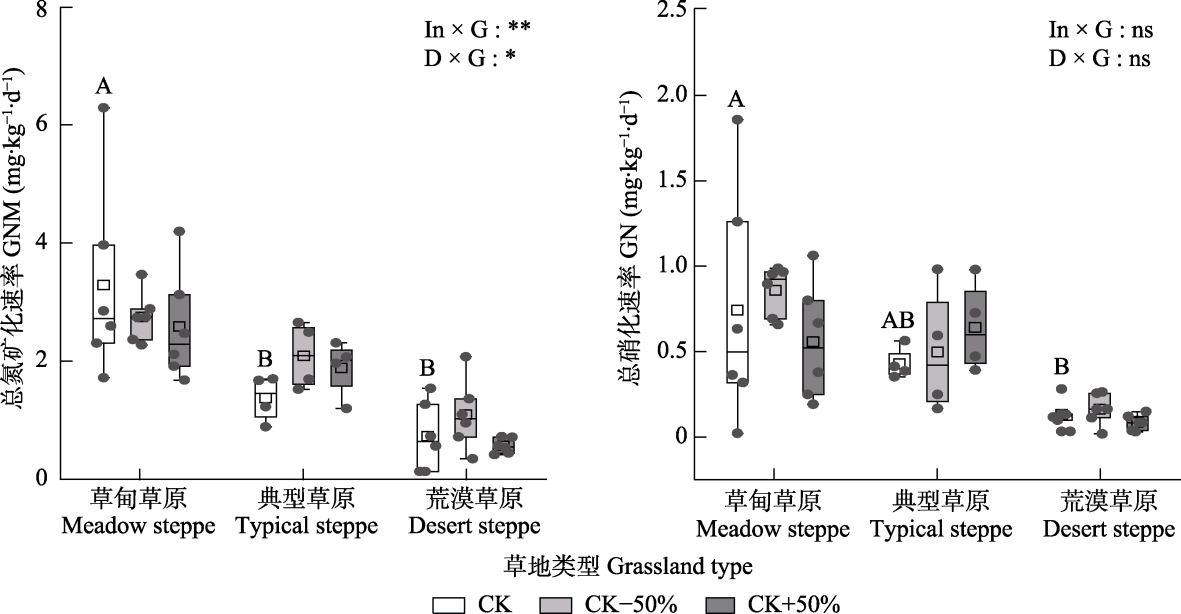
图2 降水变化对不同类型草原土壤总氮矿化速率和总硝化速率的影响。CK, 对照; CK-50%, 减少50%降水; CK+50%, 增加50%降水。不同大写字母表示CK处理下不同草原类型差异显著(p < 0.05); *表示相同草原类型下降水处理的差异显著(p < 0.05); ns, p > 0.05。D × G, 减雨和草原类型的交互作用; In × G, 增雨和草原类型的交互作用。箱形图显示中位数(□)、平均数(—)、第25百分位数和第75百分位数以及近似95%置信区间, 每一个点代表一个样本。
Fig. 2 Effect of precipitation change on soil gross nitrogen mineralization rate (GNM) and soil gross nitrification rate (GN) in different grassland types. CK, control; CK-50%, decreased precipitation by 50%; CK+50%, increased precipitation by 50%. Different uppercase letters indicate significant differences in different grassland types under CK treatment (p < 0.05); ns, p > 0.05. *, significant differences among different precipitation treatments within the same grassland types (p < 0.05). D × G, the interaction of precipitation reduction and grassland types; In × G, the interaction of precipitation enhancement and grassland types. Box plots, average plots (—), display medians (50th percentile), 25th and 75th percentiles, and approximate 95% confidence intervals. Each dot represents a sample.
| df | 土壤总氮矿化速率 GNM | 土壤总硝化速率 GN | |
|---|---|---|---|
| 固定效应 Fixed effect | |||
| 草原类型 Grassland type (G) | 3 | <0.001*** | <0.001*** |
| 改变降水 Change precipitation (P) | 3 | <0.001*** | <0.001*** |
| 草原类型×改变降水 G × P | 9 | <0.001*** | <0.001*** |
| 随机效应 Random effect | |||
| 土壤含水量 SWC | - | 0.034* | 0.459 |
| 土壤温度 ST | - | 0.999 | 0.928 |
| 铵态氮含量 NH4+-N content | - | <0.001*** | 0.997 |
| 硝态氮含量 NO-3-N content | - | <0.001*** | 0.952 |
| 土壤可溶性有机碳含量 DOC content | - | 1.000 | 0.681 |
| 土壤可溶性有机氮含量 DON content | - | 0.771 | <0.001*** |
| 微生物生物量碳含量 MBC content | - | 0.962 | 0.942 |
| 微生物生物量氮含量 MBN content | - | <0.001*** | 0.938 |
表2 不同草原类型改变降水下土壤因子对土壤总氮矿化、总硝化速率影响的混合线性模型分析(p值)
Table 2 Linear mixed model of the effect of soil factor on gross nitrogen mineralization (GNM) rate and gross nitrification (GN) rate of soil in different grassland types (p value)
| df | 土壤总氮矿化速率 GNM | 土壤总硝化速率 GN | |
|---|---|---|---|
| 固定效应 Fixed effect | |||
| 草原类型 Grassland type (G) | 3 | <0.001*** | <0.001*** |
| 改变降水 Change precipitation (P) | 3 | <0.001*** | <0.001*** |
| 草原类型×改变降水 G × P | 9 | <0.001*** | <0.001*** |
| 随机效应 Random effect | |||
| 土壤含水量 SWC | - | 0.034* | 0.459 |
| 土壤温度 ST | - | 0.999 | 0.928 |
| 铵态氮含量 NH4+-N content | - | <0.001*** | 0.997 |
| 硝态氮含量 NO-3-N content | - | <0.001*** | 0.952 |
| 土壤可溶性有机碳含量 DOC content | - | 1.000 | 0.681 |
| 土壤可溶性有机氮含量 DON content | - | 0.771 | <0.001*** |
| 微生物生物量碳含量 MBC content | - | 0.962 | 0.942 |
| 微生物生物量氮含量 MBN content | - | <0.001*** | 0.938 |
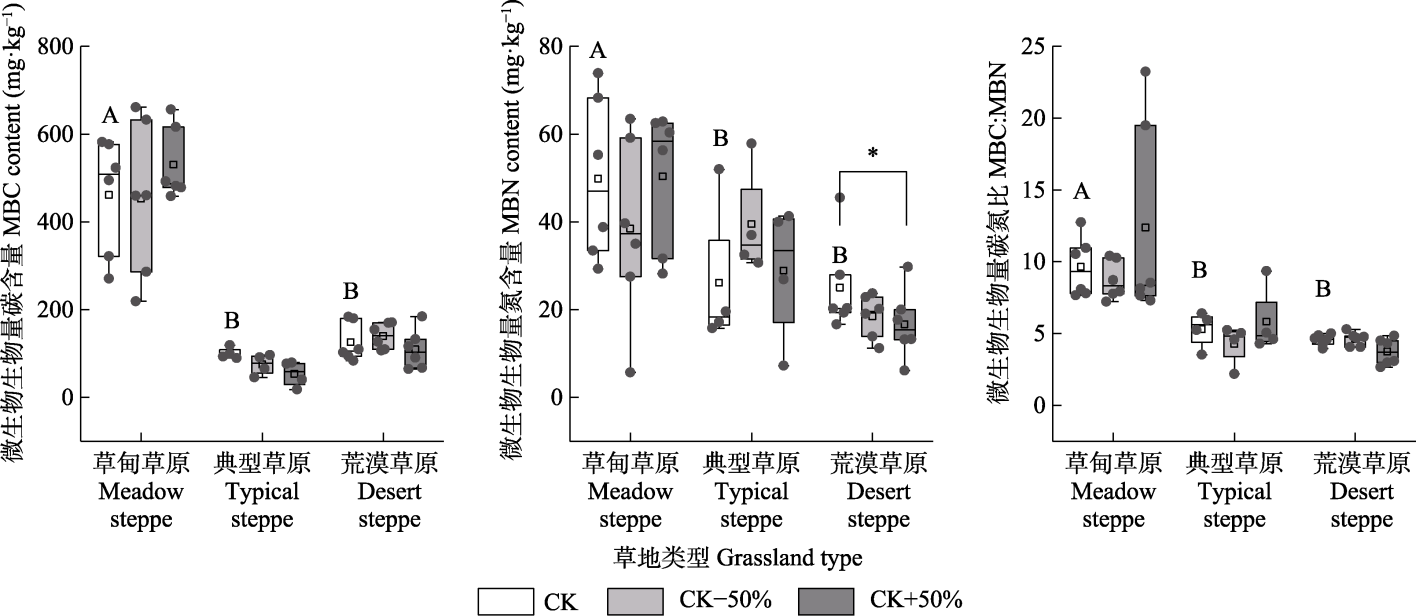
图3 降水变化对不同草原类型土壤微生物生物量的影响。CK, 对照; CK-50%, 减少50%降水; CK+50%, 增加50%降水。不同大写字母表示CK处理下不同草原类型差异显著(p < 0. 05); *表示相同草原类型下降水处理的差异显著(p < 0.05) )。箱形图显示中位数(□)、平均数(—)、第25百分位数和第75百分位数以及近似95%置信区间, 每一个点代表一个样本。
Fig. 3 Effect of precipitation change on soil microbial biomass in different grassland types. MBC, microbial biomass carbon; MBN, microbial biomass nitrogen. CK, control; CK-50%, decreased precipitation by 50%; CK+50%, increased precipitation by 50%. Different uppercase letters indicate significant differences in different grassland types under CK treatment (p < 0.05); *, significant differences among different precipitation treatments within the same grassland types (p < 0.05). Box plots, average plots (—), display medians (50th percentile), 25th and 75th percentiles, and approximate 95% confidence intervals. Each dot represents a sample.
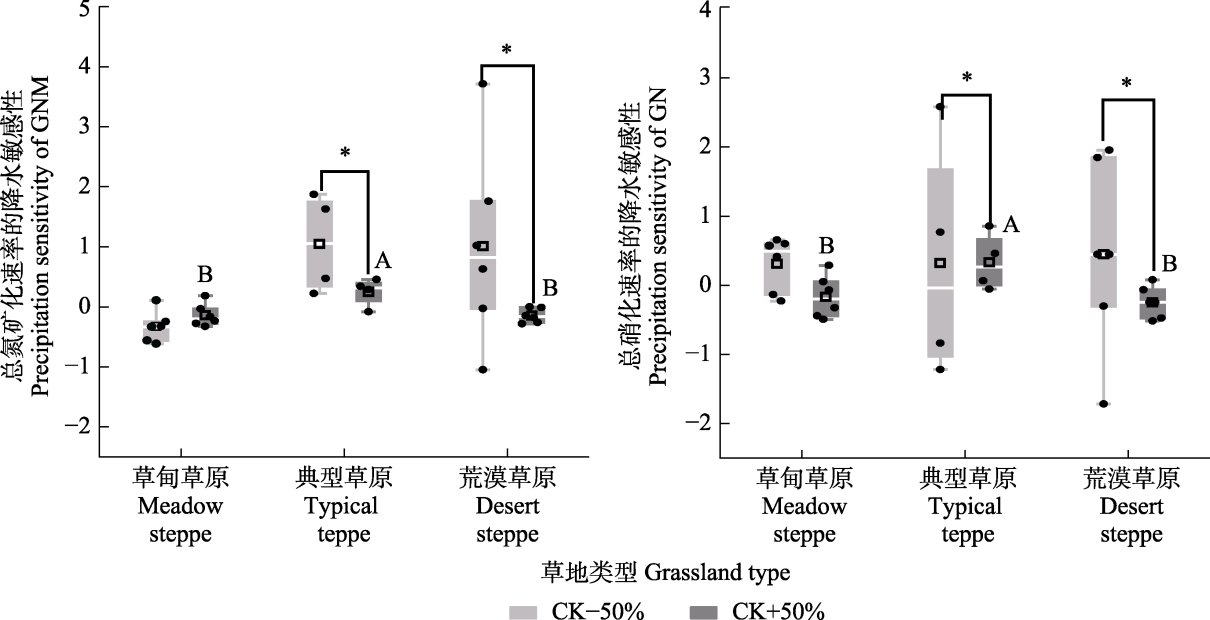
图4 不同草原类型降水变化对土壤总氮矿化、总硝化速率敏感性的影响。CK-50%, 减少50%降水; CK+50%, 增加50%降水。不同大写字母表示在CK+50%处理下不同草原类型差异显著(p < 0.05); *表示相同草原类型下降水处理的差异显著(p < 0.05)。箱形图显示中位数(□)、平均数(—)、第25百分位数和第75百分位数以及近似95%置信区间, 每一个点代表一个样本。
Fig. 4 Effect of precipitation change on the sensitivity of soil gross nitrogen mineralization rate (GNM) and soil gross nitrification rate (GN) in different grassland type. CK-50%, decreased precipitation by 50%; CK+50%, increased precipitation by 50%. Different uppercase letters indicate significant differences in different grassland types under CK+50% treatment (p < 0.05); ns, p > 0.05. *, significant differences among different precipitation treatments within the same grassland types (p < 0.05). D × G, the interaction of precipitation reduction and grassland types; In × G, the interaction of precipitation enhancement and grassland types. Box plots, average plots (—), display medians (50th percentile), 25th and 75th percentiles, and approximate 95% confidence intervals. Each dot represents a sample.
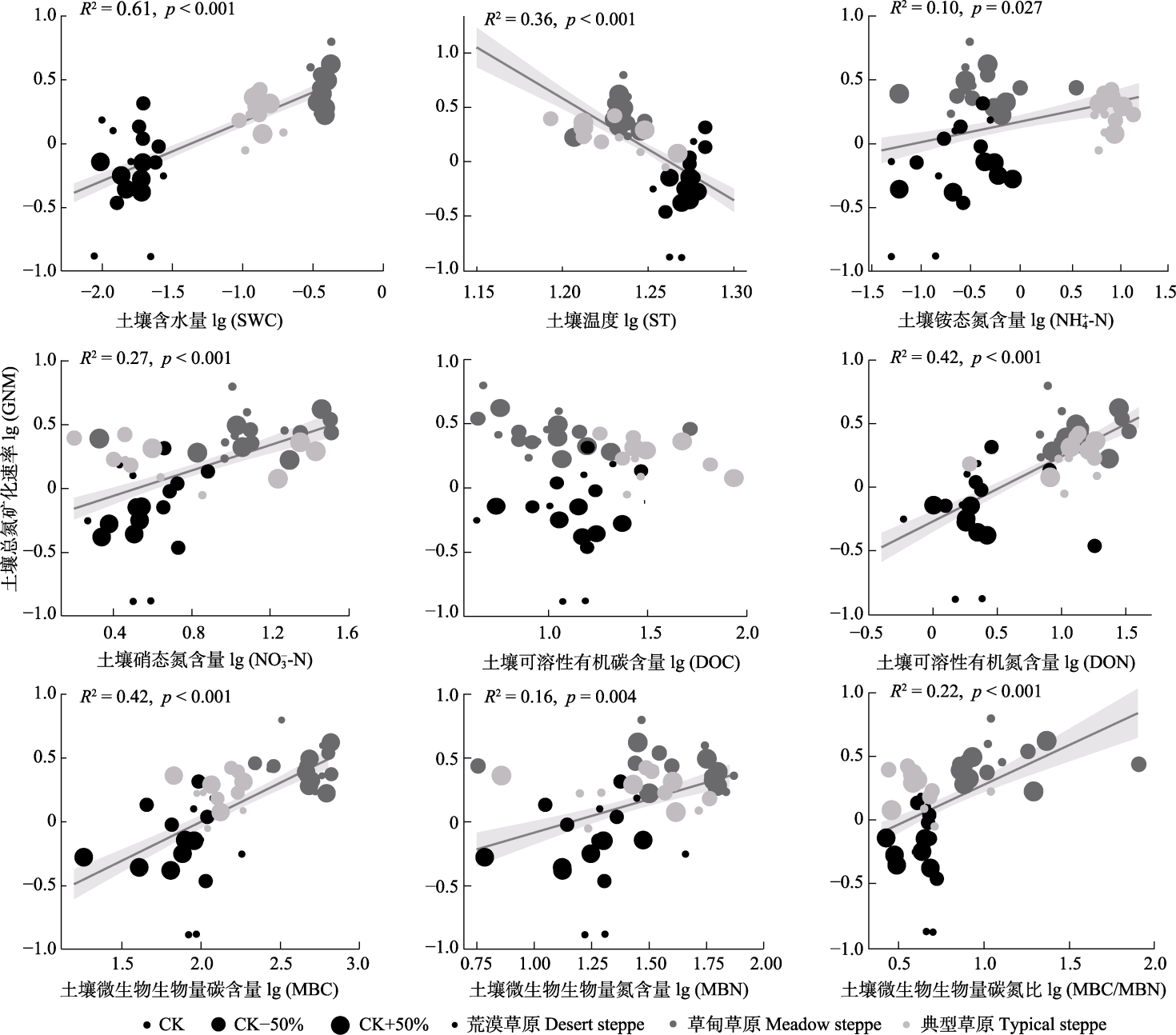
图5 土壤总氮矿化速率与土壤理化性质的关系。CK, 对照; CK-50%, 减少50%降水; CK+50%, 增加50%降水。
Fig. 5 Relationship between soil gross nitrogen mineralization rate (GNM) and soil physicochemical properties. CK, control; CK-50%, decreased precipitation by 50%; CK+50%, increased precipitation by 50%. DOC, dissolved organic carbon content; DON, dissolved organic nitrogen content; GNM, gross nitrogen mineralization rate; MBC, microbial biomass carbon content; MBN, microbial biomass nitrogen content; NH4+-N, ammonium nitrogen content; NO-3-N, nitrate nitrogen content; ST, soil temperature; SWC, soil water content.
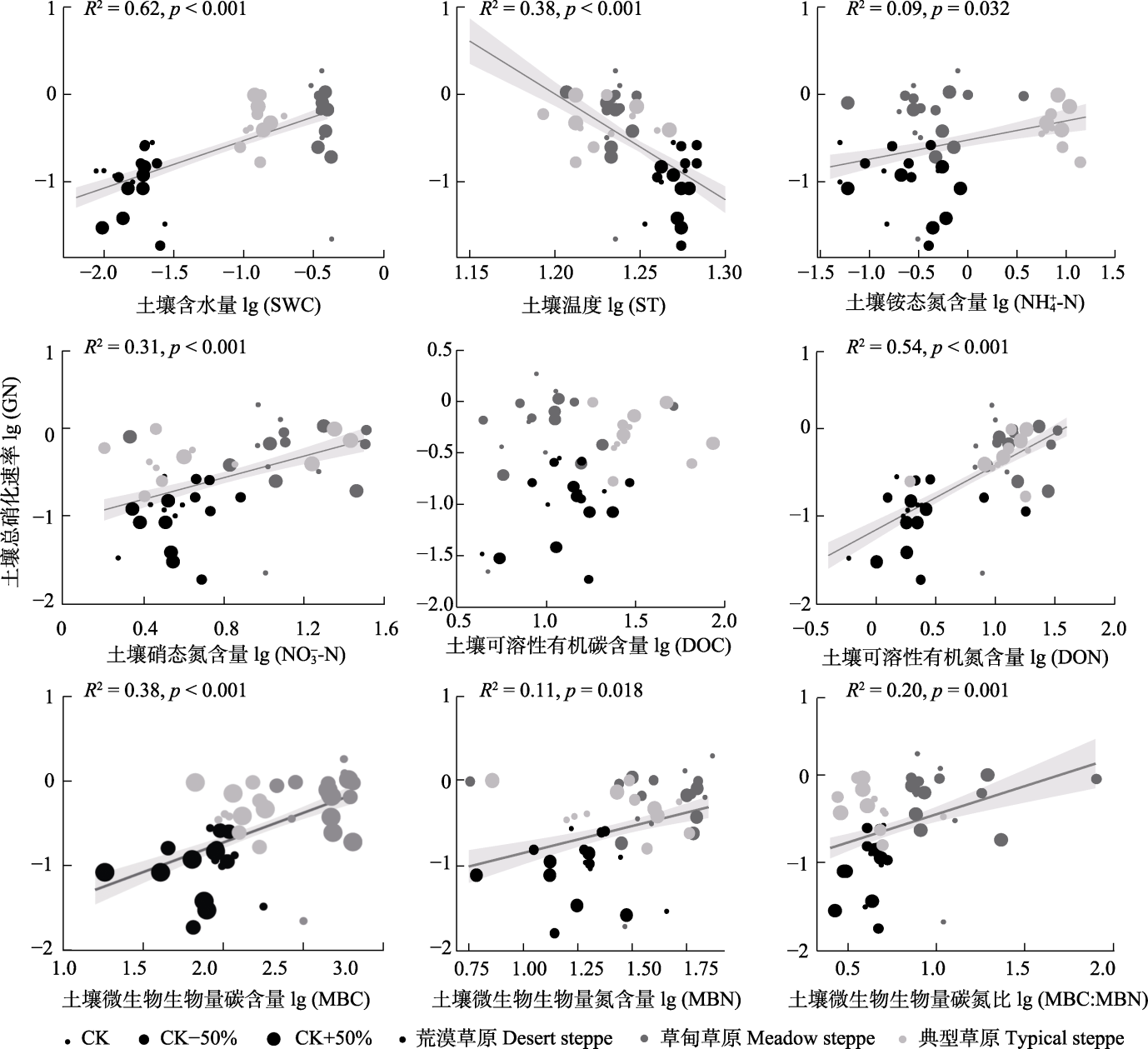
图6 土壤总硝化速率与土壤理化性质的关系。CK, 对照; CK-50%, 减少50%降水; CK+50%, 增加50%降水。
Fig. 6 Relationship between soil gross nitrification rate (GN) and soil physicochemical properties. CK, control; CK-50%, decreased precipitation by 50%; CK+50%, increased precipitation by 50%. DOC, dissolved organic carbon content; DON, dissolved organic nitrogen content; GN, global gross nitrification rate; MBC, microbial biomass carbon content; MBN, microbial biomass nitrogen content; NH4+-N, ammonium nitrogen content; NO-3-N, nitrate nitrogen content; ST, soil temperature; SWC, soil water content.
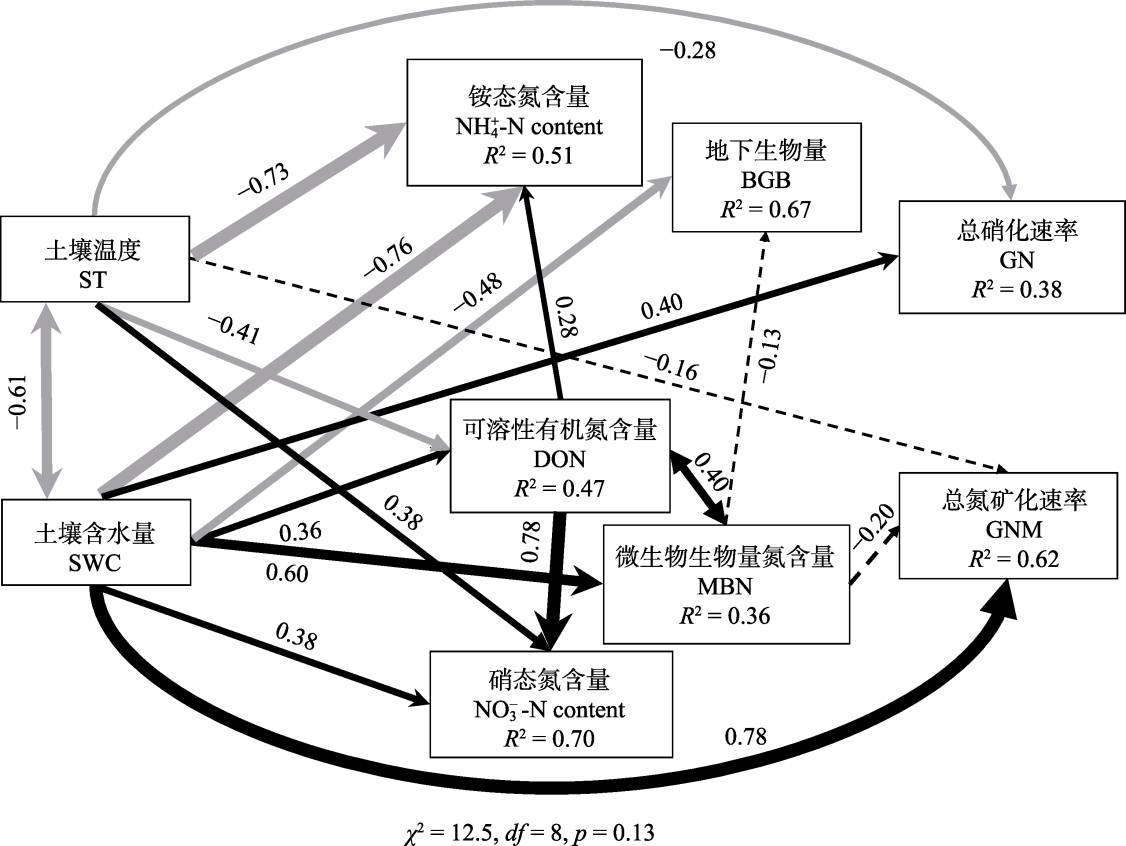
图7 土壤理化性质、地下生物量和土壤微生物生物量对中国北方草原土壤总氮矿化速率的影响。黑色和灰色实线分别表示正、负关系, 黑色虚线箭头表示关系不显著, 箭头宽度与关系的强度成正比。
Fig. 7 Effect of soil physicochemical properties, below-ground biomass (BGB), and soil microbial biomass on soil gross nitrogen mineralization rate (GNM) in northern grasslands. Black and grey solid lines indicated positive and negative relationships, respectively. Black dotted lines indicate an insignificant relationship. The arrow width is proportional to the strength of the relationship. DOC, dissolved organic carbon content; DON, dissolved organic nitrogen content; GN, soil gross nitrification rate; MBN, microbial biomass nitrogen content; ST, soil temperature; SWC, soil water content.
| [1] | Brown VA (2021). An introduction to linear mixed-effects modeling in R. Advances in Methods and Practices in Psychological Science, 4, 2515245920960351. DOI: 10.1177/2515245920960351. |
| [2] | Chen H, Gurmesa GA, Zhang W, Zhu X, Zheng M, Mao Q, Zhang T, Mo J (2016). Nitrogen saturation in humid tropical forests after 6 years of nitrogen and phosphorus addition: hypothesis testing. Functional Ecology, 30, 305-313. |
| [3] | Chen L, Zeng J, Li H, Liu SL, Lei LQ, Liu SR (2020). Research advances in the soil nitrogen cycle under global precipitation pattern change. Acta Ecologica Sinica, 40, 7543-7551. |
| [ 陈琳, 曾冀, 李华, 刘士玲, 雷丽群, 刘世荣 (2020). 全球降水格局变化下土壤氮循环研究进展. 生态学报, 40, 7543-7551.] | |
| [4] | Cheng Y, Wang J, Mary B, Zhang JB, Cai ZC, Chang SX (2013). Soil pH has contrasting effects on gross and net nitrogen mineralizations in adjacent forest and grassland soils in central Alberta, Canada. Soil Biology & Biochemistry, 57, 848-857. |
| [5] | Dannenberg MP, Wise EK, Smith WK (2019). Reduced tree growth in the semiarid United States due to asymmetric responses to intensifying precipitation extremes. Science Advances, 5, eaaw0667. DOI: 10.1126/sciadv.aaw0667. |
| [6] | Diao HJ, Yang JQ, Hao J, Yan XD, Dong KH, Wang CH (2023). Seasonal precipitation regulates magnitude and direction of the effect of nitrogen addition on net ecosystem CO2 exchange in saline-alkaline grassland of northern China. Science of the Total Environment, 877, 162907. DOI: 10.1016/j.scitotenv.2023.162907. |
| [7] | Elrys AS, Abo El-Maati MF, Dan X, Wen Y, Mou J, Abdelghany AE, Uwiragiye Y, Tang S, Wu Y, Meng L, Zhang J, Müller C (2024). Aridity creates global thresholds in soil nitrogen retention and availability. Global Change Biology, 30, e17003. DOI: 10.1111/gcb.17003. |
| [8] |
Elrys AS, Ali A, Zhang H, Cheng Y, Zhang J, Cai ZC, Müller C, Chang SX (2021). Patterns and drivers of global gross nitrogen mineralization in soils. Global Change Biology, 27, 5950-5962.
DOI PMID |
| [9] | Feyissa A, Yang F, Wu J, Chen Q, Zhang D, Cheng X (2021). Soil nitrogen dynamics at a regional scale along a precipitation gradient in secondary grassland of China. Science of the Total Environment, 781, 146736. DOI: 10.1016/j.scitotenv.2021.146736. |
| [10] | Gao CY, Qi ZY, Zheng H, Chen XY, Qin JM, Hao J, Zhang NL, Wang CH, Dong KH (2022). Response of soil available nutrients and microbial characteristics to short-term grazing intensities. Acta Agrestia Sinica, 30, 1641-1650. |
|
[ 高昌宇, 齐志远, 郑慧, 陈玺洋, 秦加敏, 郝杰, 张乃莉, 王常慧, 董宽虎 (2022). 土壤有效养分和微生物特征对短期不同放牧强度的响应. 草地学报, 30, 1641-1650.]
DOI |
|
| [11] | Grimm NB, Chapin III FS, Bierwagen B, Gonzalez P, Groffman PM, Luo Y, Melton F, Nadelhoffer K, Pairis A, Raymond PA, Schimel J, Williamson CE (2013). The impacts of climate change on ecosystem structure and function. Frontiers in Ecology and the Environment, 11, 474-482. |
| [12] | Holguin J, Collins SL, McLaren JR (2022). Belowground responses to altered precipitation regimes in two semi-arid grasslands. Soil Biology & Biochemistry, 171, 108725. DOI: 10.1016/j.soilbio.2022.108725. |
| [13] | Hook PB, Burke IC (1995). Evaluation of methods for estimating net nitrogen mineralization in a semiarid grassland. Soil Science Society of America Journal, 59, 831-837. |
| [14] | The Intergovernmental Panel on Climate Change (IPCC) (2021). Climate Change 2021: The Physical Science Basis: Contribution of Working Group I to the Sixth Assessment Report of the Intergovernmental Panel on Climate Change. Cambridge University Press, Cambridge, UK. |
| [15] |
Keuper F, Dorrepaal E, van Bodegom PM, van Logtestijn R, Venhuizen G, van Hal J, Aerts R (2017). Experimentally increased nutrient availability at the permafrost thaw front selectively enhances biomass production of deep-rooting subarctic peatland species. Global Change Biology, 23, 4257-4266.
DOI PMID |
| [16] | Kirkham D, Bartholomew WV (1954). Equations for following nutrient transformations in soil, utilizing tracer data. Soil Science Society of America Journal, 18, 33-34. |
| [17] | Kou D, Peng Y, Wang G, Ding J, Chen Y, Yang G, Fang K, Liu L, Zhang B, Müller C, Zhang J, Yang Y (2018). Diverse responses of belowground internal nitrogen cycling to increasing aridity. Soil Biology & Biochemistry, 116, 189-192. |
| [18] | Larsen KS, Andresen LC, Beier C, Jonasson S, Albert KR, Ambus P, Arndal MF, Carter MS, Christensen S, Holmstrup M, Ibrom A, Kongstad J, van der Linden L, Maraldo K, Michelsen A, et al. (2011). Reduced N cycling in response to elevated CO2, warming, and drought in a Danish heathland: synthesizing results of the CLIMAITE project after two years of treatments. Global Change Biology, 17, 1884-1899. |
| [19] | Leyrer V, Patulla M, Hartung J, Marhan S, Poll C (2022). Long-term manipulation of mean climatic conditions alters drought effects on C- and N-cycling in an arable soil. Global Change Biology, 28, 3974-3990. |
| [20] | Li S, Chen YN, Wei W, Fang GH, Duan WL (2024). The increase in extreme precipitation and its proportion over global land. Journal of Hydrology, 628, 130456. DOI: 10.1016/j.jhydrol.2023.130456. |
| [21] | Maxwell TL, Canarini A, Bogdanovic I, Böckle T, Martin V, Noll L, Prommer J, Séneca J, Simon E, Piepho HP, Herndl M, Pötsch EM, Kaiser C, Richter A, Bahn M, Wanek W (2022). Contrasting drivers of belowground nitrogen cycling in a montane grassland exposed to a multifactorial global change experiment with elevated CO2, warming, and drought. Global Change Biology, 28, 2425-2441. |
| [22] | Mukherjee S, Aadhar S, Stone D, Mishra V (2018). Increase in extreme precipitation events under anthropogenic warming in India. Weather and Climate Extremes, 20, 45-53. |
| [23] | Niu S, Classen AT, Dukes JS, Kardol P, Liu L, Luo Y, Rustad L, Sun J, Tang J, Templer PH, Thomas RQ, Tian D, Vicca S, Wang YP, Xia J, Zaehle S (2016). Global patterns and substrate-based mechanisms of the terrestrial nitrogen cycle. Ecology Letters, 19, 697-709. |
| [24] | Peng YF, Zhao X, Wu DH, Tang BJ, Xu PP, Du XZ, Wang HY (2018). Spatiotemporal variability in extreme precipitation in China from observations and projections. Water, 10, 1089. DOI: 10.3390/w10081089. |
| [25] | Qiu Y, Jiang Y, Guo L, Zhang L, Burkey KO, Zobel RW, Reberg-Horton SC, Shew HD, Hu S (2019). Shifts in the composition and activities of denitrifiers dominate CO2 stimulation of N2O emissions. Environmental Science & Technology, 53, 11204-11213. |
| [26] | Shi Y, Wang J, Ao Y, Han J, Guo Z, Liu X, Zhang J, Mu C, Le Roux X (2021). Responses of soil N2O emissions and their abiotic and biotic drivers to altered rainfall regimes and co-occurring wet N deposition in a semi-arid grassland. Global Change Biology, 27, 4894-4908. |
| [27] |
Song L, Wang JS, Zhang RY, Pan JX, Li Y, Wang S, Niu SL (2023). Threshold responses of soil gross nitrogen transformation rates to aridity gradient. Global Change Biology, 29, 4018-4027.
DOI PMID |
| [28] |
Šťovíček A, Kim M, Or D, Gillor O (2017). Microbial community response to hydration-desiccation cycles in desert soil. Scientific Reports, 7, 45735. DOI: 10.1038/srep45735.
PMID |
| [29] | Sun JM, Liu W, Pan QM, Zhang B, Lv YX, Huang JH, Han XG (2022). Positive legacies of severe droughts in the Inner Mongolia grassland. Science Advances, 8, eadd6249. DOI: 10.1126/sciadv.add6249. |
| [30] |
Wang C, Chen Z, Unteregelsbacher S, Lu H, Gschwendtner S, Gasche R, Kolar A, Schloter M, Kiese R, Butterbach-Bahl K, Dannenmann M (2016). Climate change amplifies gross nitrogen turnover in montane grasslands of Central Europe in both summer and winter seasons. Global Change Biology, 22, 2963-2978.
DOI PMID |
| [31] | Wang CH, Wang NN, Zhu JX, Liu Y, Xu XF, Niu SL, Yu GR, Han XG, He NP (2018a). Soil gross N ammonification and nitrification from tropical to temperate forests in eastern China. Functional Ecology, 32, 83-94. |
| [32] | Wang N, Li L, Dannenmann M, Luo Y, Xu X, Zhang B, Chen S, Dong K, Huang J, Xu X, Wang C (2021). Seasonality of gross ammonification and nitrification altered by precipitation in a semi-arid grassland of Northern China. Soil Biology & Biochemistry, 154, 108146. DOI: 10.1016/j.soilbio.2021.108146. |
| [33] | Wang X, Yoo K, Wackett AA, Gutknecht J, Amundson R, Heimsath A (2018b). Soil organic carbon and mineral interactions on climatically different hillslopes. Geoderma, 322, 71-80. |
| [34] | Westra S, Fowler HJ, Evans JP, Alexander LV, Berg P, Johnson F, Kendon EJ, Lenderink G, Roberts NM (2014), Future changes to the intensity and frequency of short-duration extreme rainfall. Reviews of Geophysics, 52, 522-555. |
| [35] | Wu Q, Yue K, Ma Y, Heděnec P, Cai Y, Chen J, Zhang H, Shao J, Chang SX, Li Y (2022). Contrasting effects of altered precipitation regimes on soil nitrogen cycling at the global scale. Global Change Biology, 28, 6679-6695. |
| [36] | Xu C (2022). The Resistance and Resilience of Grassland Productivity to Extreme Drought. PhD dissertation, Lanzhou University, Lanzhou. 14-18. |
| [ 徐翀 (2022). 极端干旱背景下草原植被生产力的抵抗力和恢复力研究. 博士学位论文, 兰州大学, 兰州. 14-18.] | |
| [37] | Xu GR, Li G, Wu JQ, Ma WW, Wang HY, Yuan JY, Li XD (2023). Effects of rainfall amount and frequencies on soil net nitrogen mineralization in Gahai wet meadow in the Qinghai-Tibetan Plateau. Scientific Reports, 13, 14860. DOI: 10.1038/s41598-023-39267-3. |
| [38] | Xu XH, Diao HJ, Qin CY, Hao J, Shen Y, Dong KH, Wang CH (2021). Response of soil net nitrogen mineralization to different levels of nitrogen addition in a saline-alkaline grassland of northern China. Chinese Journal of Plant Ecology, 45, 85-95. |
| [ 徐小惠, 刁华杰, 覃楚仪, 郝杰, 申颜, 董宽虎, 王常慧 (2021). 华北盐渍化草地土壤净氮矿化速率对不同水平氮添加的响. 植物生态学报, 45, 85-95.] | |
| [39] | Yang WH, Ryals RA, Cusack DF, Silver WL (2017). Cross-biome assessment of gross soil nitrogen cycling in California ecosystems. Soil Biology & Biochemistry, 107, 144-155. |
| [40] | Zeng YL, Xiang WH, Deng XW, Fang X, Liu C, Peng CH (2014). Soil N forms and gross transformation rates in Chinese subtropical forests dominated by different tree species. Plant and Soil, 384, 231-242. |
| [41] | Zhang C, Lei S, Wu H, Liao L, Wang X, Zhang L, Song Z (2024). Simplified microbial network reduced microbial structure stability and soil functionality in alpine grassland along a natural aridity gradient. Soil Biology & Biochemistry, 191, 109366. DOI: 10.1038/s41598-023-39267-3. |
| [42] | Zhang J, Zhu T, Cai Z, Müller C (2011). Nitrogen cycling in forest soils across climate gradients in Eastern China. Plant and Soil, 342, 419-432. |
| [43] | Zhang JB, Wang L, Zhao W, Hu HF, Feng XJ, Müller C, Cai ZC (2016). Soil gross nitrogen transformations along the Northeast China Transect (NECT) and their response to simulated rainfall events. Scientific Reports, 6, 22830. DOI: 10.1038/srep22830. |
| [44] |
Zhang KC, Qiu YP, Zhao YF, Wang SH, Deng J, Chen MF, Xu XY, Wang H, Bai TS, He TQ, Zhang Y, Chen HH, Wang Y, Hu SJ (2023). Moderate precipitation reduction enhances nitrogen cycling and soil nitrous oxide emissions in a semi-arid grassland. Global Change Biology, 29, 3114-3129.
DOI PMID |
| [45] | Zhao FC, Chen HF, Wang YH, Dong KH, Wang CH, Chen XP (2022). Response of rhizosphere soil properties to changed precipitation and nitrogen addition in a salinized grassland. Acta Agrestia Sinica, 30, 2430-2437. |
|
[ 赵芳草, 陈鸿飞, 王一昊, 董宽虎, 王常慧, 陈晓鹏 (2022). 盐渍化草地根际土壤理化性质对降水改变和氮添加的响应. 草地学报, 30, 2430-2437.]
DOI |
|
| [46] | Zhao W, Zhang JB, Müller C, Cai ZC (2018). Effects of pH and mineralisation on nitrification in a subtropical acid forest soil. Soil Research, 56, 275-283. |
| [47] | Zhao YY, Ding Y, Hou XY, Li FY, Han WJ, Yun XJ (2017). Effects of temperature and grazing on soil organic carbon storage in grasslands along the Eurasian steppe eastern transect. PLoS ONE, 12, e0186980. DOI: 10.1371/journal.pone.0186980. |
| [48] | Zhou ZH, Wang CK, Luo YQ (2018). Response of soil microbial communities to altered precipitation: a global synthesis. Global Ecology and Biogeography, 27, 1121-1136. |
| [49] | Zhou ZH, Wang CK, Zheng MH, Jiang LF, Luo YQ (2017). Patterns and mechanisms of responses by soil microbial communities to nitrogen addition. Soil Biology & Biochemistry, 115, 433-441. |
| [1] | 葛小彩, 李锦隆, 孙俊, 武盼盼, 胡丹丹, 程栋梁, 钟全林. 武夷山亚高山草甸土壤呼吸组分特征及影响因素[J]. 植物生态学报, 2025, 49(3): 502-512. |
| [2] | 韩雨晴, 熊伟, 吴波, 卢琦, 杨文斌, 刘雅莉, 张景波, 辛智鸣, 马迎宾, 廉泓林, 王思涵. 乌兰布和沙漠梭梭茎干液流对降雨脉冲的响应[J]. 植物生态学报, 2024, 48(9): 1172-1179. |
| [3] | 李蓓蓓, 张明军, 车存伟, 刘泽琛, 钟晓菲, 张园园, 张宇. 基于稳定同位素示踪的不同覆砂厚度下枣树水分利用策略[J]. 植物生态学报, 2024, 48(9): 1202-1212. |
| [4] | 王袼, 胡姝娅, 李阳, 陈晓鹏, 李红玉, 董宽虎, 何念鹏, 王常慧. 不同类型草原土壤净氮矿化速率的温度敏感性[J]. 植物生态学报, 2024, 48(4): 523-533. |
| [5] | 代景忠, 白玉婷, 卫智军, 张楚, 辛晓平, 闫玉春, 闫瑞瑞. 羊草功能性状对施肥的动态响应[J]. 植物生态学报, 2023, 47(7): 943-953. |
| [6] | 夏璟钰, 张扬建, 郑周涛, 赵广, 赵然, 朱艺旋, 高洁, 沈若楠, 李文宇, 郑家禾, 张雨雪, 朱军涛, 孙建新. 青藏高原那曲高山嵩草草甸植物物候对增温的异步响应[J]. 植物生态学报, 2023, 47(2): 183-194. |
| [7] | 丛楠, 张扬建, 朱军涛. 北半球中高纬度地区近30年植被春季物候温度敏感性[J]. 植物生态学报, 2022, 46(2): 125-135. |
| [8] | 臧永新, 马剑英, 周晓兵, 陶冶, 尹本丰, 沙亚古丽•及格尔, 张元明. 极端干旱和降水对沙垄不同坡向坡位短命植物地上生产力的影响[J]. 植物生态学报, 2022, 46(12): 1537-1550. |
| [9] | 徐小惠, 刁华杰, 覃楚仪, 郝杰, 申颜, 董宽虎, 王常慧. 华北盐渍化草地土壤净氮矿化速率对不同水平氮添加的响应[J]. 植物生态学报, 2021, 45(1): 85-95. |
| [10] | 赵河聚, 岳艳鹏, 贾晓红, 成龙, 吴波, 李元寿, 周虹, 赵雪彬. 模拟增温对高寒沙区生物土壤结皮-土壤系统呼吸的影响[J]. 植物生态学报, 2020, 44(9): 916-925. |
| [11] | 郑甲佳, 黄松宇, 贾昕, 田赟, 牟钰, 刘鹏, 查天山. 中国森林生态系统土壤呼吸温度敏感性空间变异特征及影响因素[J]. 植物生态学报, 2020, 44(6): 687-698. |
| [12] | 宋小艳, 王根绪, 冉飞, 杨燕, 张莉, 肖瑶. 东北大兴安岭演替初期泰加林灌草层典型植物开花物候与生长对模拟暖干化气候的响应[J]. 植物生态学报, 2018, 42(5): 539-549. |
| [13] | 李旭华, 孙建新. Biome-BGC模型模拟阔叶红松林碳水通量的参数敏感性检验和不确定性分析[J]. 植物生态学报, 2018, 42(12): 1131-1144. |
| [14] | 李晋波, 姚楠, 赵英, 范庭, 张建国, 兰志龙, 易军, 司炳成. 不同放牧条件下锡林郭勒典型草原土壤水分分布特征及降水入渗估算[J]. 植物生态学报, 2018, 42(10): 1033-1042. |
| [15] | 杨开军, 杨万勤, 谭羽, 贺若阳, 庄丽燕, 李志杰, 谭波, 徐振锋. 川西亚高山云杉林冬季土壤呼吸对雪被去除的短期响应[J]. 植物生态学报, 2017, 41(9): 964-971. |
| 阅读次数 | ||||||
|
全文 |
|
|||||
|
摘要 |
|
|||||
Copyright © 2022 版权所有 《植物生态学报》编辑部
地址: 北京香山南辛村20号, 邮编: 100093
Tel.: 010-62836134, 62836138; Fax: 010-82599431; E-mail: apes@ibcas.ac.cn, cjpe@ibcas.ac.cn
备案号: 京ICP备16067583号-19